
Crossosoma is a genus of the plant family Crossosomataceae. It consists of two species of shrubs.

Crossosomataceae is a small plant family, consisting of four genera of shrubs found only in the dry parts of the American southwest and Mexico. This family has included up to ten species in the past, although as of 2021 six species are still recognised. Crossosoma are shrub-like plants which can vary from being 50 cm to 5 meters tall, with small alternating leaves that surround the stem, or leaves clustered in small spurts (fascicles). Apacheria, however, has opposite leaves. Crossosoma has usually white flowers that are generally bisexual and have 5 petals attached to a nectary disk, but in Velascoa the flowers are campanulate and have an extremely reduced nectary disk.

Eriodictyon californicum is a species of plant within the family Boraginaceae. It is also known as yerba santa, mountain balm, bear's weed, gum bush, gum plant, and consumptive weed. Less common names include Herbe des Montagnes, Herbe à Ourse, Herbe Sacrée, Herbe Sainte, Hierba Santa, Holy Herb, and Tarweed.

Papaver californicum is a species of poppy known by the common names fire poppy and western poppy.
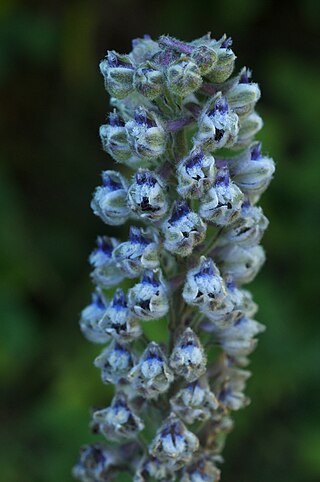
Delphinium californicum is a species of larkspur known as California larkspur. This wildflower is endemic to California, where it is a resident of the chaparral slopes of the San Francisco Bay Area and Central Coast.
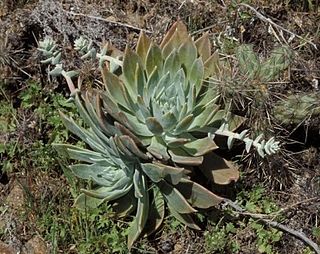
Dudleya traskiae is a rare succulent plant known by the common name Santa Barbara Island liveforever. This Dudleya is endemic to Santa Barbara Island, one of the Channel Islands of California, where it grows on rocky bluffs. The plant has a basal rosette of flat, spade-shaped fleshy leaves up to 15 centimeters long, which are pale green to yellowish. It erects tall stems bearing dense, rounded inflorescences of many bright yellow flowers.
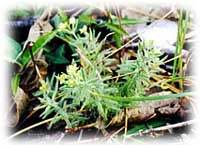
Galium californicum is a species of flowering plant in the coffee family known by the common name California bedstraw.
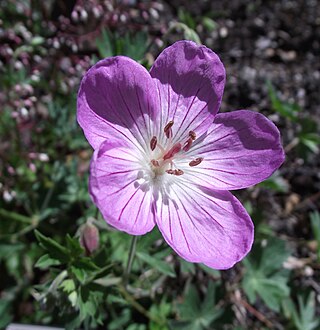
Geranium californicum is a species of Geranium known by the common name California cranesbill. It is endemic to California, where it grows in the Sierra Nevada and coastal ranges in the southern part of the state.
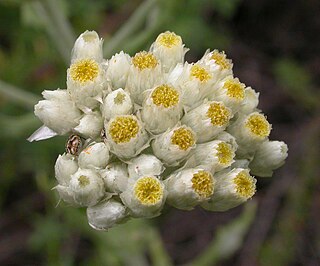
Pseudognaphalium californicum is a species of flowering plant in the family Asteraceae known by several common names, including ladies' tobacco, California rabbit tobacco, California cudweed, and California everlasting.

Allium praecox is a species of wild onion known by the common name early onion.

Crossosoma bigelovii, known by the common name ragged rockflower, is one of only a few species in the flowering plant family Crossosomataceae.

Lithophragma cymbalaria is a species of flowering plant in the saxifrage family known by the common name mission woodland star.

Lithospermum californicum is a species of flowering plant in the borage family known by the common name California stoneseed. It is native to southern Oregon and northern California, where it can be found in many types of mountain habitat, such as forest, woodland, and chaparral, sometimes on serpentine soils.
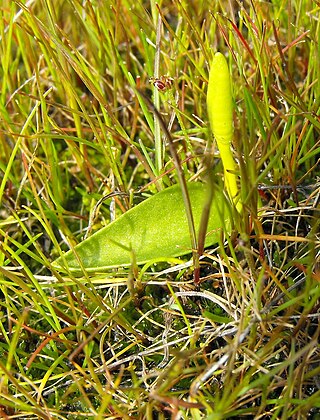
Ophioglossum californicum, known by the common name California adder's tongue, is an uncommon species of fern in the family Ophioglossaceae.

Polemonium californicum is a species of flowering plant in the phlox family known by the common names moving polemonium, low Jacob's-ladder, and California Jacob's ladder. It is native to the northwestern United States, where it grows in shady and moist habitat, such as mountain woodlands. It is a hairy, glandular rhizomatous perennial herb forming clumps of several decumbent to erect stems 30 to 50 centimeters in maximum height. The leaves are up to 20 centimeters long and are compound, made up of several pairs of oval to lance-shaped leaflets. The leaflet at the tip of the leaf is often fused to the pair behind it. The inflorescence is a crowded cluster of bell-shaped flowers each up to 1.5 centimeters wide. The flower is blue or purple with a yellow center and a whitish tubular throat. The fruit is a capsule.
Polygonum californicum is a species of flowering plant in the buckwheat family known by the common name California knotweed. It is native to the west coast of the United States from Washington, Oregon, and northern and central California in the Coast Ranges and Sierra Nevada foothills as far south as Napa and Tulare Counties. It can be found in many types of open habitats.

Pycnanthemum californicum is a species of flowering plant in the mint family known by the common name Sierra mint, mountain mint, and California mint.

Ribes californicum, with the common name hillside gooseberry, is a North American species of currant. It is endemic to California, where it can be found throughout many of the California Coast, Transverse, and Peninsular Ranges in local habitat types such as chaparral and woodlands.

Sisyrinchium californicum is a species of flowering plant in the iris family known by the common names golden blue-eyed grass, yellow-eyed-grass, and golden-eyed-grass. It is native to the west coast of North America from British Columbia to central California, where it grows in moist habitat, often in coastal areas.

Thlaspi californicum is a rare species of flowering plant in the family Brassicaceae known by the common name Kneeland Prairie penny-cress. It is endemic to California, where it is known from only one stretch of grassland in Humboldt County. It is threatened by development. It is a federally listed endangered species of the United States.


















